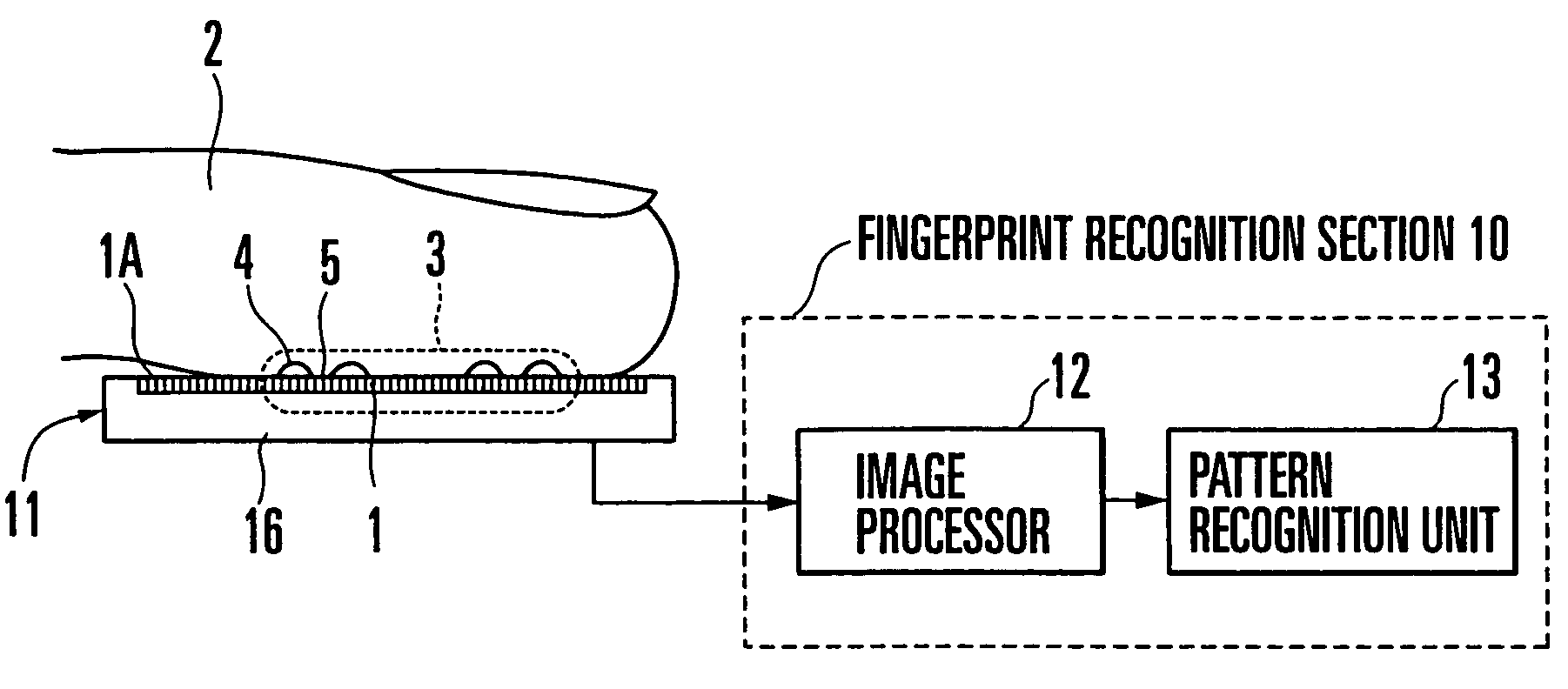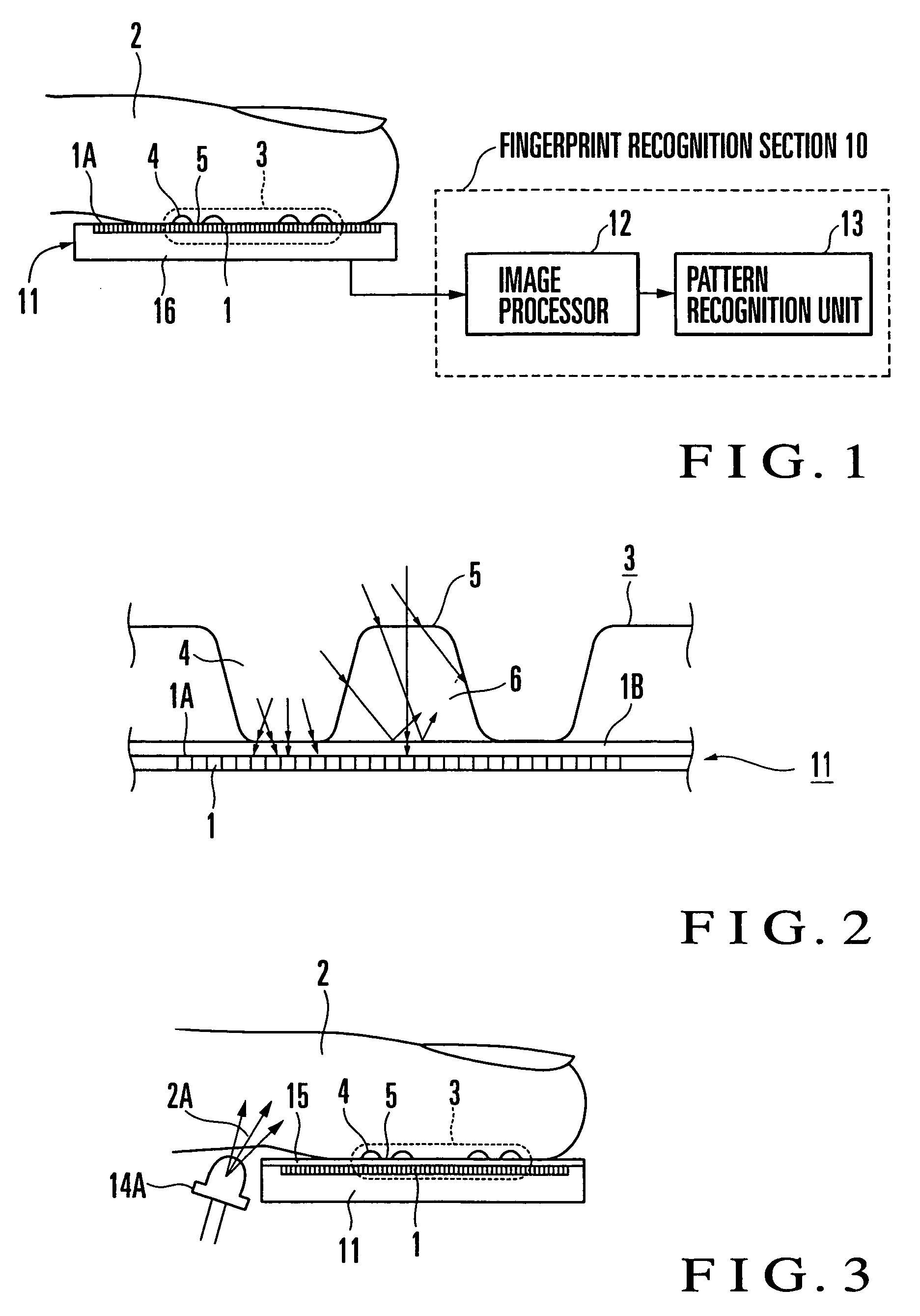Fingerprint input apparatus
a technology of input apparatus and fingerprint, which is applied in the direction of subcutaneous biometric features, instruments, person identification, etc., can solve the problems of large thickness and size of the apparatus, inability to manufacture the apparatus at low cost, and the resultant image tends to distor
- Summary
- Abstract
- Description
- Claims
- Application Information
AI Technical Summary
Benefits of technology
Problems solved by technology
Method used
Image
Examples
first embodiment
[0015]FIG. 1 shows a fingerprint input apparatus according to the present invention. Referring to FIG. 1, reference numeral 11 denotes a two-dimensional image sensor (to be referred to as an image sensor hereinafter) for two-dimensionally detecting the light intensity in accordance with the three-dimensional pattern of a skin surface 3 of a finger 2; 12, an image processor for image-processing an output from the image sensor 11 to generate a fingerprint pattern; and 13, a pattern recognition unit for extracting the features of the fingerprint pattern generated by the image processor 12 and recognizing the pattern by comparing the extracted features with a predetermined reference pattern.
[0016]The image sensor 11 comprises a substrate 16 and a large number of light-receiving elements 1 two-dimensionally arranged in a matrix on the substrate 16. A two-dimensional image is formed on the basis of an output from each light-receiving element 1. As shown in FIG. 2, a transparent cover 1B c...
second embodiment
[0024]FIG. 3 shows the schematic arrangement of a fingerprint input apparatus according to the present invention.
[0025]In the first embodiment, the scattered light from the inside of the finger 2 is generated by the ambient light of the finger 2. For this reason, any special light source need not be provided. However, when a fingerprint input apparatus is used in a place where no ambient light is available, a light source such as an LED (Light-Emitting Diode) is arranged to irradiate the finger 2.
[0026]Referring to FIG. 3, reference numeral 14A denotes a light source arranged on the same surface side as that of an image sensor 11 so as to oppose a finger pad portion 2A of a finger 2. The finger pad portion 2A is irradiated upward with light from the light source 14A to generate scattered light inside the finger 2. As compared with the case in which the light source is disposed above the finger 2 to irradiate it, the light source does not interfere with operation of placing the finge...
third embodiment
[0029]FIG. 4 shows the schematic arrangement of a fingerprint input apparatus according to the present invention.
[0030]Referring to FIG. 4, reference numeral 14B denotes a light source arranged on the same surface side as that of an image sensor 11 so as to oppose a fingertip portion 2B of a finger 2. The fingertip portion 2B is irradiated obliquely upward with light from the light source 14B to generate scattered light inside the finger 2.
[0031]According to this embodiment, since the fingertip portion 2B has an almost hemispherical surface curved downward in the forward direction, scattered light can be uniformly generated inside the finger 2 upon irradiating the finger 2 with the light from the light source 14B.
PUM
 Login to View More
Login to View More Abstract
Description
Claims
Application Information
 Login to View More
Login to View More - R&D
- Intellectual Property
- Life Sciences
- Materials
- Tech Scout
- Unparalleled Data Quality
- Higher Quality Content
- 60% Fewer Hallucinations
Browse by: Latest US Patents, China's latest patents, Technical Efficacy Thesaurus, Application Domain, Technology Topic, Popular Technical Reports.
© 2025 PatSnap. All rights reserved.Legal|Privacy policy|Modern Slavery Act Transparency Statement|Sitemap|About US| Contact US: help@patsnap.com



